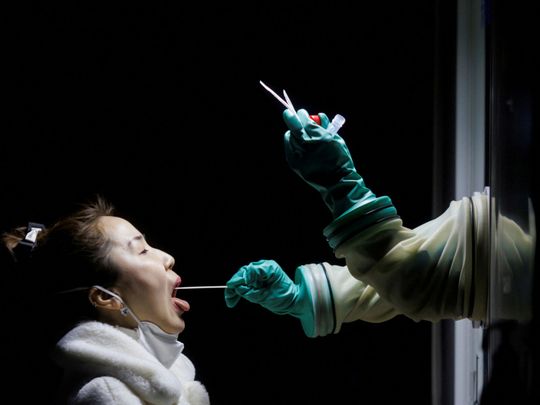
China’s daily COVID-19 caseload exceeded 1,000 for the first time in two years, as the highly infectious omicron variant spawns outbreaks at a scale only seen at the peak of the start of the pandemic in Wuhan.
The country reported 1,100 domestic infections on Friday, data from the National Health Commission showed. The tally has ballooned from just over 300 cases a day in less than a week, presenting a significant challenge to China’s ongoing, zero-tolerance approach to the virus.
The Covid Zero strategy that helped keep China largely virus-free for much of the pandemic now appears to be buckling as omicron repeatedly breaks through one of the world’s most stringent remaining containment regimes. Covid’s spread in the nation’s biggest cities, including financial hub Shanghai, also makes it difficult to deploy the aggressive but disruptive restrictions officials are increasingly turning to, chief among them lockdowns.
Despite the swelling outbreak, China is seeing more people infected without obvious symptoms than those who are sickened by the virus - likely resulting from omicron’s diminished virulence and China’s mass vaccination drive that’s seen nearly 90% of its 1.4 billion people fully inoculated with locally-developed shots and more than one-third boosted. Of Friday’s cases, 703 were asymptomatic.
An outbreak in the northeastern province of Jilin - which borders Russia and North Korea - has seen authorities move quickly to build three makeshift hospitals with a capacity for some 1,200 beds.
China erected a number of temporary hospitals in Wuhan in 2020, some built in as little as 10 days and then used to treat moderate and severe patients. China’s policy is still to isolate all cases of Covid, regardless of severity, to contain further spread.

That approach will be maintained, according to a person familiar with the country’s plans, and places that are experiencing strong outbreaks should consider building temporary hospitals, especially to isolate cases with no symptoms. That would leave actual hospitals designated to deal with Covid free for the more severe cases.
The eastern port city of Qingdao is also building multiple makeshift hospitals amid omicron’s explosive spread in a number of schools. Local officials and school heads there have received disciplinary warnings for failing to tame the outbreak.
Meanwhile in Shanghai, which is confronting its worst outbreak of the pandemic, authorities are testing students from kindergarten to college. The city has largely refrained from deploying the sweeping curbs commonly used in smaller cities, such as lockdowns, but the growing outbreak may test the limit of this more targeted response.
Not in community
Most of the newly reported infections in Shanghai are among people who have already been isolated, the person familiar with China’s response said, for being a close contact of a case, for example.
Just two of the 75 Covid cases reported in the city Friday were in the community, which may explain why authorities haven’t intensified their response or deployed city-wide testing as yet. Bigger cities with sophisticated contact-tracing capacity won’t necessarily deploy mass testing as long as the outbreak is considered to be limited and under control, the person said.
Chinese Premier Li Keqiang said Friday that the world should be working more closely together to create the conditions for a return to normal post-pandemic. In a press conference marking the end of the annual National People’s Congress in Beijing, he said officials will work to make China’s response more scientific and targeted and to maintain the normal functioning of everyday life and supply chains.
Repeated mass testing of workers in the northeast city of Tianjin in January saw Toyota Motor Corp. halt production there for about 10 days, contributing to a 15% drop in output for the Japanese car giant that month. Mass testing is a key tool in the Covid Zero arsenal as it helps root out infections quickly and among asymptomatic people.












